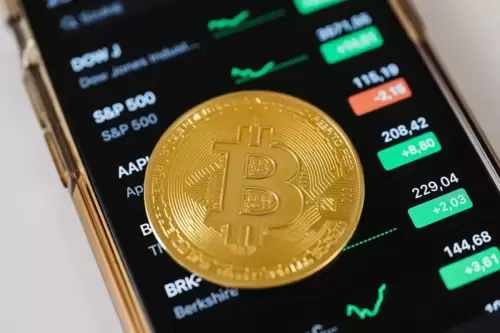 |
|
 |
|
 |
|
 |
|
 |
|
 |
|
 |
|
 |
|
 |
|
 |
|
 |
|
 |
|
 |
|
 |
|
 |
|
鎖のデータは、ビットコインハッシュレートが否定的な調整を経ているため、再び上昇していることを示しています。

On-chain data from Blockchain.com reveals that the Bitcoin Hashrate is heading up again as the Difficulty has gone through a negative adjustment.
BlockChain.comのオンチェーンデータは、ビットコインハッシュレートが否定的な調整を受けたため、再び上昇していることを明らかにしています。
Bitcoin miners seem to be back in expansion mode as the latest adjustments to the chain’s Difficulty saw the metric go down.
チェーンの難易度の最新の調整により、メトリックが下がったため、ビットコインマイナーは拡張モードに戻っているようです。
Bitcoin Hashrate Remains Flat Despite Recent Difficulty Increase
ビットコインハッシュレートは、最近の困難の増加にもかかわらず、平坦なままです
On Saturday, May 3rd, the Bitcoin network went through its latest Difficulty adjustment and eased things up for the miners, breaking a streak of four consecutive increases prior to that.
5月3日土曜日、ビットコインネットワークは最新の難易度調整を経て、鉱夫のために物事を緩和し、それ以前に4連続の増加の連続を破りました。
The “Difficulty” here is a feature built into the BTC blockchain that basically controls how hard the miners find it to mine blocks on the network. This metric’s value changes in response to the pace at which the miners perform their duty.
ここの「難易度」は、鉱山労働者がネットワーク上のブロックを採掘するのがどれほど難しいかを基本的に制御するBTCブロックチェーンに組み込まれた機能です。このメトリックの値は、鉱夫が義務を果たすペースに応じて変化します。
The chain automatically adjusts its Difficulty about every two weeks and the rule that Satoshi wrote in for it to base these adjustments off is simple: keep the block time consistent around 10 minutes.
チェーンは自動的に2週間ごとに難易度を調整し、佐藤がこれらの調整を下すために書いたルールは簡単です。ブロック時間を約10分間維持します。
This means that when the miners go through blocks at a rate faster than 10 mins per block, the chain is forced to up its Difficulty. Similarly, it has to ease things up if the validators are being slow, so that they can get back up to the standard pace.
これは、鉱夫がブロックあたり10分より速い速度でブロックを通過すると、チェーンがその難しさを強制されることを意味します。同様に、バリッターが遅い場合は、標準のペースに戻ることができるように、物事を緩和する必要があります。
Miners become faster or slower at their task when the total computing power employed by them, known as the Hashrate, changes. As the below chart from Blockchain.com shows, miners were in a phase of rapid expansion earlier, which is why BTC had to up its Difficulty four times straight.
鉱夫は、ハッシュレートとして知られる彼らが採用している総コンピューティングパワーが変化すると、タスクでより速くまたは遅くなります。 BlockChain.comの以下のチャートが示すように、鉱夫は早期に急速に拡大する段階にありました。そのため、BTCは4回まっすぐに困難を上げなければなりませんでした。
Now, the existence of Difficulty has one major consequence for the Bitcoin miners: no matter how much they invest into their facilities, they can’t collectively pull out more block subsidy than the network allows them to.
現在、困難の存在は、ビットコインマイナーに1つの大きな結果をもたらします。施設にいくら投資しても、ネットワークが許すよりも多くのブロック補助金を集めて引き出すことはできません。
“Block subsidy” is the BTC reward that the miners receive as compensation for adding a block to the network. It makes up for the major part of the miner income, with the transaction fees occupying a smaller portion.
「ブロック補助金」とは、ネットワークにブロックを追加するための補償として鉱夫が受け取るBTC報酬です。それは鉱山労働者の収入の大部分を補い、取引手数料はより少ない部分を占めています。
Since the Difficulty always brings the miners back to a speed of 10 minutes per block, these validators continue to receive about the same amount of this reward every day, regardless of the hashrate.
困難は常に鉱夫をブロックあたり10分間の速度に戻すため、これらのバリデーターは、ハッシュレートに関係なく、毎日ほぼ同じ量のこの報酬を受け取り続けています。
In other words, a higher amount of computing power competes for the same amount of revenue as before, whenever the Hashrate goes up (note that this is only true following the next Difficulty adjustment; miners can earn differently from the norm in the in-between period).
言い換えれば、ハッシュレートが上昇するたびに、より多くのコンピューティングパワーが以前と同じ収益を競い合います(これは、次の難易度の調整に続いて真実であることに注意してください。
This suggests that, in theory, validators who fail to expand proportionately to the global Bitcoin Hashrate increase fall behind the competition and earn less income than before, since the collective BTC income of the miners is constrained.
これは、理論的には、グローバルなビットコインハッシュレートの増加に比例して拡大できないバリデーターは、鉱夫の集合BTC収入が制約されているため、以前よりも競争に遅れをとり、以前よりも少ない収入を得ることを示唆しています。
Such miners who suffer from a revenue squeeze following a Difficulty increase might have no choice, but to disconnect from the network. From the Hashrate chart, it’s apparent that the indicator’s value crashed during the last-third of April. It’s possible that the large Difficulty increase was what triggered it.
困難の増加に続いて収入の絞りに苦しむそのような鉱山労働者は、ネットワークから切断することができないかもしれません。ハッシュレートチャートから、4月の最後の3分の1でインジケーターの値がクラッシュしたことは明らかです。大きな困難の増加がそれを引き起こしたものである可能性があります。
With the Difficulty now finally observing a cooldown in response to this decline in the Hashrate, miners may once again be encouraged to add to their facilities. And indeed, the most recent trend in the 7-day average of the metric has been pointing in this direction so far.
ハッシュレートのこの減少に対応して、最終的にクールダウンを観察するのが難しいため、鉱夫は再び施設に追加するよう奨励されるかもしれません。そして実際、メトリックの7日間の平均における最新の傾向は、これまでのところこの方向を指しています。
免責事項:info@kdj.com
提供される情報は取引に関するアドバイスではありません。 kdj.com は、この記事で提供される情報に基づいて行われた投資に対して一切の責任を負いません。暗号通貨は変動性が高いため、十分な調査を行った上で慎重に投資することを強くお勧めします。
このウェブサイトで使用されているコンテンツが著作権を侵害していると思われる場合は、直ちに当社 (info@kdj.com) までご連絡ください。速やかに削除させていただきます。


























































